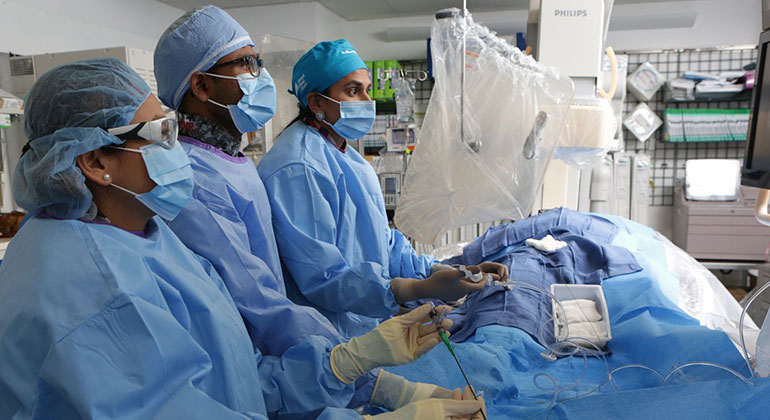Mount Sinai Researchers Find Improved Cholesterol Efflux Linked to Plaque Stabilization in Statin-Treated Patients
Researchers at the Mount Sinai Cardiac Catheterization Lab have found that patients treated with intensive statin therapy undergo changes in plaque morphology, specifically a thickening of the fibrous cap, that are associated with improved cholesterol transport and distinct genomic changes. The results of this study, titled YELLOW II (Reduction in Yellow Plaque by Aggressive Lipid-Lowering Therapy), were published October 29 in the Journal of the American College of Cardiology, simultaneously with presentation on October 31 in the Featured Science Session at TCT 2016 in Washington, DC.
“While previous studies including our own have shown that treatment with high-dose statins results in plaque stabilization, we wanted to explore the mechanistic basis of changes in plaque morphology, especially focusing on how is the fat removed from the plaque,” said lead investigator Annapoorna Kini, MD, Director of the Cardiac Catheterization Laboratory at Mount Sinai Heart. “Our results are promising and provide a wider snapshot of how high-dose statin therapy exerts its influence, and points to underlying changes in gene expression that result from treatment. We see many patients who develop blockages, despite taking their medications and improving their LDL cholesterol levels and blood chemistry. We’re optimistic this research will help lead to future answers.”
The study included 85 patients with stable multivessel coronary artery disease who underwent PCI for a culprit lesion. Patients also underwent multimodality imaging of an obstructive nonculprit lesion with optical coherence tomography (OCT), near-infrared spectroscopy, and intravascular ultrasound (IVUS). Cholesterol efflux capacity (CEC) was assessed. Following enrollment, patients were treated with high doses of rosuvastatin for 8-12 weeks and then follow-up imaging, CEC and genomic changes were reassessed.
In addition to markedly lower bad cholesterol, inflammation and improved cholesterol efflux, the researchers also evaluated gene expression in isolated samples of peripheral blood mononuclear cells before and after high-dose statin therapy. They identified 6 differentially expressed genes which were involved in cholesterol synthesis (SQLE), regulation of fatty acid unsaturation (FADS1), cellular cholesterol uptake (LDLR), cholesterol efflux (ABCA1, ABCG1), and inflammation (DHCR24).
“The transcriptomic research is an attempt to isolate specific genomic biomarkers that might one day be used to identify responders to statin therapy, without the need for invasive imaging,” said Joel Dudley, PhD, Associate Professor of Genetics and Genomic Sciences and Director of the Institute for Next Generation Healthcare at the Icahn School of Medicine at Mount Sinai.
Dr. Narula, the director of imaging services at Sinai added that “this study was a unique attempt at bring the best of clinical, intravascular imaging, cell biology and genomic studies together. This is the true example of the translational science as best as it gets.”
“This study was able to recruit 85 patients in a short time from a single center for this very involved research effort. It is a monumental feat and speaks high of Mount Sinai Catheterization laboratory which carries out the largest number of interventions in the country with the best safety data,” said study author Samin K. Sharma, MD, Director of Clinical and Interventional Cardiology at The Mount Sinai Hospital. “This study has now demonstrated that Sinai cath lab can deliver the quality research at the same level as it has done so for outstanding patient care.”
The YELLOW II trial was conducted with support from the Investigator-Sponsored Study Program of AstraZeneca, partial support from InfraReDx and Mount Sinai catheterization laboratory endowment funds.
About the Mount Sinai Health System
Mount Sinai Health System is one of the largest academic medical systems in the New York metro area, with more than 43,000 employees working across eight hospitals, over 400 outpatient practices, nearly 300 labs, a school of nursing, and a leading school of medicine and graduate education. Mount Sinai advances health for all people, everywhere, by taking on the most complex health care challenges of our time — discovering and applying new scientific learning and knowledge; developing safer, more effective treatments; educating the next generation of medical leaders and innovators; and supporting local communities by delivering high-quality care to all who need it.
Through the integration of its hospitals, labs, and schools, Mount Sinai offers comprehensive health care solutions from birth through geriatrics, leveraging innovative approaches such as artificial intelligence and informatics while keeping patients’ medical and emotional needs at the center of all treatment. The Health System includes approximately 7,300 primary and specialty care physicians; 13 joint-venture outpatient surgery centers throughout the five boroughs of New York City, Westchester, Long Island, and Florida; and more than 30 affiliated community health centers. We are consistently ranked by U.S. News & World Report's Best Hospitals, receiving high "Honor Roll" status, and are highly ranked: No. 1 in Geriatrics and top 20 in Cardiology/Heart Surgery, Diabetes/Endocrinology, Gastroenterology/GI Surgery, Neurology/Neurosurgery, Orthopedics, Pulmonology/Lung Surgery, Rehabilitation, and Urology. New York Eye and Ear Infirmary of Mount Sinai is ranked No. 12 in Ophthalmology. U.S. News & World Report’s “Best Children’s Hospitals” ranks Mount Sinai Kravis Children's Hospital among the country’s best in several pediatric specialties.
For more information, visit https://www.mountsinai.org or find Mount Sinai on Facebook, Twitter and YouTube.

Mount Sinai Launches Mobile App to Optimize Care for Heart Attack Patients
Aug 16, 2021 View All Press Releases